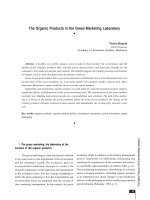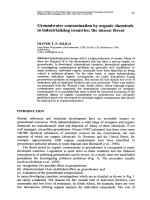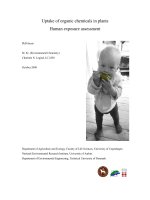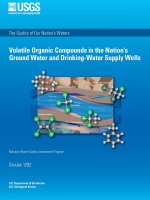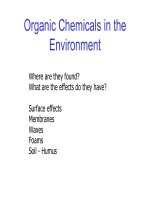Organic Chemicals in the Environment pdf
Bạn đang xem bản rút gọn của tài liệu. Xem và tải ngay bản đầy đủ của tài liệu tại đây (1.73 MB, 41 trang )
Organic Chemicals in the
Environment
Where are they found?
What are the effects do they have?
Surface effects
Membranes
Waxes
Foams
Soil - Humus
The air-water interface
The surface tension of water is 0.073 N/m. Ions can increase
this value somewhat to 0.075 N/m. However, organic
compounds Tend to lower the value. The surface tension of
organic liquids (e.g. octane, benzene etc.) range from
0.020 to 0.050 N/m.
There are two types of surface adlayers on water.
1. Organic thin films such as oil spills (prior to oxidative
weathering). These compounds are both insoluble and
less dense than water.
2. Surfactants are amphipathic molecules. There are dry
surfactants such as detergents (mostly hydrophobic) and
wet surfactants such as proteins (mostly hydrophilic).
Surface tension
Liquids tend to adopt shapes that minimize their surface area.
This places the maximum number of molecules in the bulk.
Droplets of liquids tend to be spherical because a sphere is
the shape with the smallest surface-to-volume ratio. The work
needed to change the area by dσ is:
dw = γdσ
The coefficient γ is called the surface tension. It has
dimensions of energy per unit area (J/m
2
). At constant
volume and temperature the work of surface formation is
equal to the Helmholtz free energy:
dA = γdσ
Since dA < 0 is a spontaneous change surfaces tend to contract.
Lipids and Surfactants
Both lipids and surfactants consist of a hydrophobic tail
region and a hydrophilic head group (amphipathic).
Both lipids and surfactants will orient with their head
groups pointed towards the water interface and their
tails sequestered from water.
Lipids have the ability to form a bilayer. This property
makes these molecules the constituents of biological
membranes. Bilayers can be gel-like or crystalline. They
can have a planar phase or form hexagonal phase.
Surfactants can tend to form micelles. Micelles are spherical.
The hydrophobic tails form the interior and the charged head
groups are on the surface.
Biochemistry of Lipids, Lipoproteins
and Membranes, Vance & Vance, Elsevier 1996
Lipid polymorphism
Lipid structure
Representative lipids are
shown in Figure to the
right. There are two acyl
chains on a glycerol.
The third site is a
phosphodiester with a
number of possible
groups indicated.
The fluid mosaic model of membranes
Biochemistry of Lipids, Lipoproteins
and Membranes, Vance & Vance, Elsevier 1996
Plasma membrane
Cytosol
Membrane asymmetry
The inner and outer leaflets of membrane bilayers have
different compositions. Erythrocytes are the most studied.
The cytosolic side is composed of PE and PS. The PE
distribution is ca. 80% in the inner membrane and 20% in
the outer membrane. PS is negatively charged and PE is
moderately negative in charge. The inner membrane is
thus largely negative.
The outer membrane consists of PC, sphingomyelin, and
glycolipids. Cholesterol is also important and associates
with the membrane to provide added fluidity. Plasma
membranes have equimolar quantities of cholesterol. By
contrast, the endoplasmic reticulum and mitchondrial
membranes have small amounts of cholesterol.
Detergents and
Lysophospholipids
Detergents are amphipathic
molecules that can have charged
or uncharged head groups and
single hydrophobic tails. If one
of the acyl chains is cleaved from
a lipid then a lysophospholipid is
created.
Other associating molecules
include aromatic or fused ring
compounds (dyes, purines,
pyrimidines) and alicyclic fused
ring compounds (bile salts,
cholesterol etc.).
SDS
O
O
O
OH
R
Lysophospholipid
S
O
-
O
O
O
Transmembrane Potential
Membranes are essential for life. They provide a compartment for
chemistry to occur separate from the environment. Living organisms
have also evolved to use membranes for generation and storage
of energy using photosynthesis. This is done by pumping protons
across a membrane to generate a transmembrane potential.
The transmembrane electrical potential is represented as the
voltage difference of the inside with respect to outside. We
express the potential as V (unit is the volt). In chemistry, the Nernst
equation is used to describe the dependence of the oxidation
potential on concentration. The symbol is E (or E
o
) and the unit is
also the volt.
The Nernst equation
The Nernst equation describes the potential for each half-reaction
a(Ox) + ne
-
b(Red)
The standard potential (i.e. potential at 1 molar concentration) is E
o
.
The electrode potential is given by:
where R is the gas constant and F is the Faraday (96,450 J/volt).
In an electrochemical cell where two half-reactions are combined
to make a redox reaction, the electromotive force is:
emf = E(+) - E(-)
The free energy is G = -nFE. Therefore, the standard free energy
change for a redox process is ∆G
o
= -nF(E
o
ox
-E
o
red
) = -nF∆E
o
.
E = E
o
–
RT
nF
ln
[Red]
b
[Ox]
a
Application of the Nernst equation
to membrane potential
The free energy per mole of solute moved across the membrane
∆G
conc
= -RTln(C
o
/C
i
) where C
o
is the concentration outside the
membrane and C
i
is the concentration inside the membrane. The
difference in charge concentration results in a free energy contribution
from the voltage difference ∆G
volt
= -F∆E (assuming n=1). The
balance of forces at equilibrium requires that ∆G
volt
= ∆G
conc
so that
the trans-membrane potential is obtained as follows.
∆
G
volt
=
∆
G
conc
– F∆E =–RT ln
C
o
C
i
∆E =
RT
F
ln
C
o
C
i
Natural foams from wax
Natural foams can occur from tree sap, fallen leaves and
zooplankton. For example, zooplankton are composed of
wax esters. Sometimes as much as 75% of the organism
is attributable these compounds. An example of a wax
ester is bee’s wax, which is Palmitic acid (C16:0) esterified
by a C30 chain, known as triacontanol (or melissyl alcohol).
The word "wax" is derived from the old english "weax" for
the honeycomb of the bee-hive. Thus, bee wax can be
considered as the reference wax.
Zooplankton wax
Polar zooplankton species are known for the storage of wax
esters as natural energy reserves. Thus, in the antarctic
Euphausiid Thysanoessa macrura the wax deposits reach
up to 70% of the total body lipids and contain high levels of
18:1(n-9) and 18:1(n-7) alcohols. Carnivorous zooplankton
species are characterized by the presence of shorter-chain
alcohols (14:0, 16:0) while herbivorous species, as the
calanoid copepods, contain mainly long-chain alcohols
(20:1, 22:1).
Kattner G et al., Mar Ecol Prog Ser 1996, 134, 295
Cutin is a wax found on leaves
Monoacylglycerols are important in the constitution of
cutin polymer. Cutin is the structural component of the plant
cuticle, the outermost layer of leaves and other aerial organs.
Waxes embedded in the cutin make the cuticle an efficient
barrier against desiccation, gas exchange and pathogen attack.
Cutin polyester is typically composed of esterified hydroxy-
fatty acids with 16, 18 and 22 carbon-chains and one terminal
hydroxyl (ω-position) and other hydroxyl groups in secondary
positions. The cutin polymer has been found to be based on
the inter-esterification of hydroxyacids (head-to-tail in a linear
form or cross-linked) and of glycerol esterified with various
hydroxy-fatty acids.
Graca J et al., Phytochemistry 2002, 61, 205
Cutin structure
The cuticle is part of the epidermis.
Cutin is the wax that prevents water
loss. When moving plants from sun
to shade the amount of cutin required
changes due to the amount of water
generated by photosynthesis.
The formation of a polymeric
layer of molecules to for
cutin is shown on the right.
The cutin polymer is a crosslinked
set of esters of long α,ω-alcohol
carboxylic acids or dicarboxylic acids.
Monomer composition in cutin
Biochemistry of wax synthesis
Acetyl co-A
1. Acetyl group
2. Coenzyme A
•Beta-mercaptoethylamine
•Pantothenic acid
•Phosphate
•3', 5'-adenosine diphosphate
Acetyl-CoA is an important molecule in metabolism. Its
main use is to convey the carbon atoms within the acetyl
group to the Krebs Cycle to be oxidized for energy production.
In chemical structure, acetyl-CoA is the thioester between
coenzyme A (a thiol) and acetic acid (an acyl group carrier).
It is also a carrier of two carbon units in fatty acid synthesis.
Suberin is found in bark
Waxes are also found in suberin, which is a lipidic polyester
present in tree barks, tuber skins and abscisic tissue of
falling leaves. It is also formed in plant after wounding. Upon
depolymerization, cork suberin releases a mixture of
monomers and oligomers, including monoacylglycerols of
monoacid (C22), of ω-hydroxyacids (C16, 18, 22, or 24), and
of α,ω-diacids (C16, 18, or 22). Glycerol is a major
compound of this polyester, constituting up to 20% by weight
of suberin in oak, cotton and potato. The current model
describes a monoglyceride containing 26-hydroxy-26:0 fatty
acid has been isolated from the root bark of Pentaclethra
eetveldeana, used in Congo as a traditional medicine for the
treatment of hemorrhoids, malaria and epilepsy.
Graca J et al., Chem Phys Lipids 2006, 144, 96
Graca J et al., Agric Food Chem 2000, 48, 5476
Byla B et al., Phytochemistry, 1996, 42, 501
Soil carbohydrates
Soil contains organic matter only near the surface. The
organic compounds arise mostly from the action of micro-
organisms. Most of the organic matter is trapped in colloids
and is not in equilibrium.
Soil contains a number of carbohydrates and sugars
comprising about 10% of the organic matter. Most of it is
polymeric although some monomeric sugars exist,
glucose, galactose, fructose etc.
As much as 50% of soil phosphorous is esterified as
inositol hexaphosphate (see page 64 in Larson and Weber).
OP(=O)(OH)
2
OP(=O)(OH)
2
OP(OH)
2
OP(OH)
2
(OH)
2
(O=)PO
O
O
OP(=O)(OH)
2
OP(=O)(OH)
2
OP(OH)
2
OP(OH)
2
OP(OH)
2
(OH)
2
(O=)PO
O
O
O
IP5
IP6
Inositol hexaphosphate
Phytic acid (inositol hexaphosphate
(IP6), or phytate) is the principal
storage form of phosphorus in
many plant tissues, especially in
the grass family (wheat, rice, rye,
barley etc) and beans. Phosphorus
in this form is generally not bio-
available to humans because
humans lack the digestive enzyme,
phytase, required to separate
phosphorus from the phytate molecule.
Phytic acid binds to important minerals such as calcium,
magnesium, iron and zinc and can therefore contribute to
mineral deficiencies, as the minerals are not released from
the phytate and are thus unavailable to the body.
Good and bad effects of phytate
For people with a particularly low intake of essential minerals,
especially young children and those in developing countries,
this effect can be undesirable.
A common way in developing countries to increase the bio-
availability of minerals from grains and beans is using
fermentation. Many bacteria possess phytase activity and by
fermenting grains or beans by lactic acid bacteria the phytate
is destroyed and the bioavailability of the minerals is
increased.
Phytic acid recently has been studied for its potential anti-
carcinogenic properties. Recent studies have indicated that
phytic acid may have some preventive effect in prostate,
breast, pancreatic and colon cancer. The mechanism,
however, is not yet understood.
Lignin structure
Lignin
monomer
Sample lignin
polymer structure
4-alkylcatechol
Breakdown of lignin
Lignin is a biopolymer composed of 4-alkylcatechol units.
The breakdown of lignin in the soil leads to five common
phenolic acids.
(1) (2) (3) (4) (5)
1. para-coumaric acid
2. Syringic acid
3. para-hydroxybenzoic acid
4. Vanillic acid
5. Ferulic acid
CO
2
H
O
H
CO
2
H
OCH
3
OH
CHO
2
H
OH
CHO
2
H
OH
OCH
3
CHO
2
H
OH
OCH
3
H
3
CO



